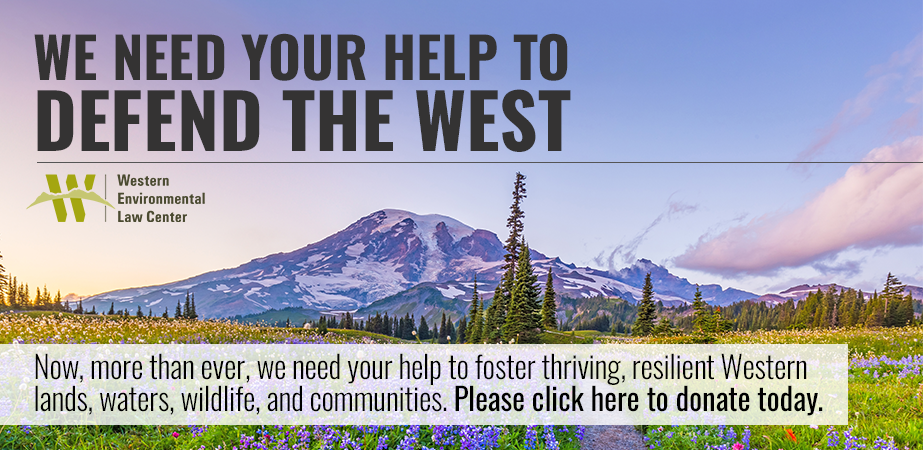Today, the Environmental Protection Information Center, Friends of the Shasta River, and the Western Environmental Law Center challenged in federal court the National Oceanic and Atmospheric Administration National Marine Fisheries Service’s (NMFS) flawed Shasta River safe harbor program. Applied here, the safe harbor program gives legal immunity to a dam owner and water diverters for harming protected species in exchange for scant stewardship practices on private lands. The recovery target for coho salmon returning to the Shasta is in the thousands, but fewer than 50 are returning each year, and the safe harbor program will not recover coho.
The groups allege NMFS violated the Endangered Species Act (ESA) by allowing a dam owner and water diverters to harm threatened coho salmon through “enhancement of survival permits” evaluated under unlawful and scientifically incorrect biological opinions. NMFS’s decision to issue the permits despite these flawed foundations violates its duty not to jeopardize threatened coho salmon or adversely modify their habitat.
“The National Marine Fisheries Service had a real opportunity to meaningfully improve conditions in the Shasta River,” said Sangye Ince-Johannsen, attorney at the Western Environmental Law Center. “Instead, the agency gave the irrigators carte blanche to continue the very same practices that so deteriorated coho habitat. These so-called ‘enhancement of survival’ permits lock in an untenable status quo for at least 20 more years—by which time coho may no longer swim up the Shasta. The use of safe harbor here makes a mockery of the Endangered Species Act.”
“Shasta River salmon are at imminent risk of extinction and we need to do everything in our power to stop that from happening,” said Tom Wheeler, executive director of EPIC. “The safe harbor agreements fail to meaningfully improve conditions in the river. We need real solutions and not handouts to billionaire landowners like Red Emmerson.”
NMFS’ Shasta River safe harbor agreements are purportedly intended to address the historic decline in coho salmon in the Shasta. While these agreements with 14 permittees are intended to provide a “net conservation benefit,” they let landowners off the hook for the damage they cause to coho. The cumulative benefit of all 14 agreements, even if all are successfully implemented, will fall far short of halting the spiraling decline, much less assure salmon recover.
“We seek a restructuring of how much-needed federal and state assistance for restoring the Shasta River is conceived and implemented,” said Bill Chesney, retired California Department of Fish and Wildlife fisheries biologist and Friends of the Shasta River board member. “Agencies first need to recommend and implement science-based flow and temperature standards sufficient to recover coho in the Shasta River. That needs to come first—not just as an afterthought once the safe harbor participants get immunity for their destructive practices.”
“We are concerned that NMFS has taken a turn down the wrong path in the way it is using safe harbor,” said Nick Joslin, a fifth-generation river user with Friends of the Shasta River. “It is saying even the most minimal improvements in habitat are grounds for giving irrigators 20 years of leeway to ignore activities that will effectively extirpate coho in the Shasta River, in exchange for doing little more than sucking up millions of dollars in public funds for ranch improvements they should be doing themselves. It’s crazy for NMFS to roll over and create a program to subsidize the destruction of our river.”
Irrigators pay $1,600 per year to participate in the safe harbor program and demand to receive millions of dollars in taxpayer-funded infrastructure work on their properties as well as immunity from the law for harming threatened coho salmon. Billionaire Red Emmerson, whose Sierra Pacific Industries is the largest private landowner in the U.S., is among the participants.
The Shasta River was once the most important salmon-producing tributary of the Klamath River. Its fish have been an essential component of traditional Tribal livelihoods and culture, as well as coastal fishing communities. However, the river’s productivity has greatly diminished due to excessive diversions—which in 2021 virtually dewatered the river on occasions.
Contacts:
Sangye Ince-Johannsen, Western Environmental Law Center, 541-778-6626, gro.w1752531814alnre1752531814tsew@1752531814jieyg1752531814nas1752531814
Nick Joslin, Friends of the Shasta River, 530-905-0264, gro.r1752531814evira1752531814tsahs1752531814@nils1752531814oj.kc1752531814in1752531814
Tom Wheeler, EPIC, 206-356-8689, gro.a1752531814inrof1752531814ilacd1752531814liw@m1752531814ot1752531814
Photos for reporter use:
Shasta River (credit: Andrew Marx)
Shasta River 1 (Credit: Andrew Marx)
Shasta River 2 (Credit: Andrew Marx)
Shasta River dry rocks (credit: Nick Joslin)
Coho juveniles 1 (photographer requested no credit)
Coho juveniles 2 (photographer requested no credit)
Coho juveniles 3 (photographer requested no credit)

